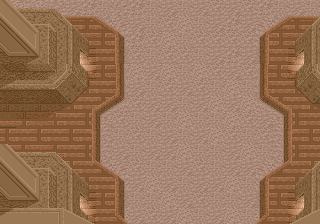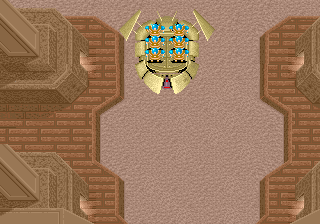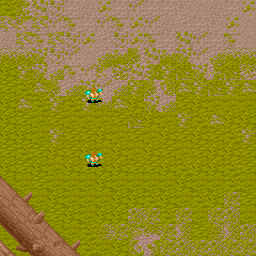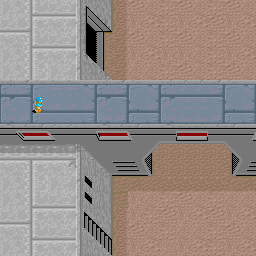Gondomania
| Gondomania |
|---|
|
Also known as: Makyou Senshi
|
The year was 1987, and flat-bottomed rowing boats were clogging our nation's canals like bacon-smothered, butter-drenched McRibs. Gondomania was upon us.
Contents
Developer Credits
At address 0xFDDD in the main CPU is an alternate set of credits and a declaration of love:
programd by T.Kitazawa,T.Nishizawa,S.Tamura planed by Y.Gondoh(paradox) supervised by T.Kitazawa copyright(c)1987 DATA EAST corporation all rights reserved I love EMIKO
Unused Graphics
![]()
Here are some unused coin denominations. The currency used in game starts at 5 coins and caps at 30 coins.
![]()
And here are some unused item prices. The lowest priced item in the game is 30 coins, and the highest is 500 coins—the 450 coin price tag is simply skipped.
Regional Differences
The international build of the game, Gondomania, seems to be more "complete" than the Japanese build, Makyou Senshi.
General
| JP | INT |
|---|---|
- The way that credits work is different between versions.
- In Makyou Senshi, both players share a credit count. Pressing 1P Start starts a 1 Player game with 1P only, pressing 2P Start starts a 2 Player game.
- In Gondomania, each player has their own credit count. Pressing 1P Start starts a 1 Player game with 1P only, pressing 2P Start starts a 1 Player game with 2P only.
- This story screen, seen after inserting a coin, is only present in Gondomania.
- The Flame, Grenade, Frag Grenade, and both Axe weapons had their ammo count increased by 10 in Gondomania.
- The player starts with 150 coins in Makyou Senshi. Gondomania is more generous, giving the player 200 coins to spend at the start.
| JP | INT |
|---|---|
 |
 |
- S. Walton and S. Jarocki, presumably the two people responsible for the bulk of the changes in Gondomania, were added to the Special Thanks section.
Music
| JP | INT |
|---|---|
The game's main track was rearranged in Gondomania to be more rockin'.
Graphics
| JP | INT |
|---|---|
 |
 |
Both players have the same ship color in Makyou Senshi, while in Gondomania, Player 1 has a nice blue ship.
| JP | INT |
|---|---|
  |
The armor breaking and death animations are flashier in Gondomania.
These ship shadows can only be seen in Gondomania. Nice little addition to the game, isn't it?
| JP | INT |
|---|---|
To make up for Player 1's new color scheme, the ship and jet items changed from blue to yellow.
| JP | INT |
|---|---|
In Makyou Senshi, the basic enemies throw single bit axes, which are easily confused with the player's own axe weapon. So, in Gondomania, those generic mooks now throw maces.
Stages
| JP | INT |
|---|---|
 |
 |
An extra ship of soldiers was added to the very start of the game. While this does add a bit of challenge, it's also an extra 120 coins if the player can destroy the ship before it leaves the screen.
| JP | INT |
|---|---|
 |
 |
Towards the end of Stage 2, the large group of boomerang-throwing barbarians was replaced by a swarm of missile launcher-toting soldiers.
| JP | INT |
|---|---|
 |
 |
Starting at around Stage 5, the number of enemies in certain screens (too many to list here) was reduced. While this may seem like a difficulty change, and it is, it's worth noting that the large amount of enemies in Makyou Senshi also caused the game to slow down quite a bit, something that's not nearly as much of an issue in Gondomania.
Bosses
The boss of each stage, barring stage 8, differs between versions. Note that the official names of the bosses are currently unknown.
| JP | INT | |
|---|---|---|
| Stage 1 | Dragon | Giant Mech |
| Stage 2 | Giant Bird | Lionman |
| Stage 3 | Giant Mech | Gunship |
| Stage 4 | Laser Ship | Dragon |
| Stage 5 | Dragon 2 | Laser Ship |
| Stage 6 | Gunship | Giant Bird |
| Stage 7 | Bomber | Mech Suit 2 |
| Stage 8 | Headless Dragon | Headless Dragon |
| Stage 9 | Lionman | Bomber |
Note that in both versions there's one boss that's used in two different stages.
| JP | INT |
|---|---|
The color of the first dragon is yellow in Makyou Senshi and blue in Gondomania. The palette was likely changed to match the blue Headless Dragon found in Stage 8.
The second dragon is not a mere palette swap, as it uses unique graphics and has a new fire-breathing attack.
| Giant Mech 1 | Giant Mech 2 |
|---|---|
 |
 |
The second Giant Mech in Gondomania, however, is just a palette swap. The only other difference between the two is that the second mech has more health.
In Gondomania, there are added tips (or not) at the start of each boss fight:
| Boss | Message |
|---|---|
| Giant Mech | SHOOT THE PILOT |
| Lionman | SHOOT THE FACE |
| Gunship | SHOOT THE WEAPONS |
| Dragon | SHOOT DRAGON'S HEAD |
| Laser Ship | SHOOT BETWEEN CANNONS |
| Giant Bird | SHOOT IT THE BODY |
| Headless Dragon | SHOOT SOMETHING |
| Bomber | YOU DIE |
References
- Pages missing developer references
- Games developed by Data East
- Pages missing publisher references
- Games published by Data East
- Arcade games
- Pages missing date references
- Games released in 1987
- Games released in February
- Games released in July
- Games with hidden developer messages
- Games with hidden developer credits
- Games with unused graphics
- Games with regional differences
Cleanup > Pages missing date references
Cleanup > Pages missing developer references
Cleanup > Pages missing publisher references
Games > Games by content > Games with hidden developer credits
Games > Games by content > Games with hidden developer messages
Games > Games by content > Games with regional differences
Games > Games by content > Games with unused graphics
Games > Games by developer > Games developed by Data East
Games > Games by platform > Arcade games
Games > Games by publisher > Games published by Data East
Games > Games by release date > Games released in 1987
Games > Games by release date > Games released in February
Games > Games by release date > Games released in July



